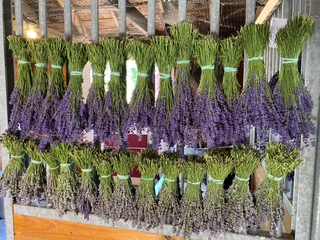Food and agriculture have always been central pillars of any community development and activity. From harvest festivals and flower-focused local events, farmers and their crops are celebrated the world over in hundreds of different ways. However, it’s rare for a farm or agricultural space to also be a beloved and beautiful community gathering place that people regularly visit and contribute to. Even pumpkin patches, a staple part of the Halloween holiday excitement in the United States, only serve as community gathering places for the autumn holiday season.
When Dr. Henry Cabrera, an anaesthesiologist by day, acquired the Lavender Waves Farm in 2016, he was confident in the farm’s potential to be the exception to the rule. His vision for the farm was for it to regain its historical significance to the local community, model modern sustainable farming practices, and become a place for learning, healing, and connection between people and nature. What started as a long-term hobby and passion project has grown into a thriving business, demonstrating a novel fusion of community fixture and agriculture plot.
The History of Lavender Waves Farm
What is now known as Lavender Waves Farm operated under a different name, and different management, for much of Kingston, Rhode Island’s local history. Old signage stored in the barn remembers the farm’s roots as Gatewood Farm, Bacon and Sausage. Local residents remember the farm’s small retail store, and the cows and pigs raised for slaughter and sale there as far back as the early 1900’s. However, despite being an old community staple, the tough realities of farming as a business led to the property’s repeated subdivision and sale to pay for itself. Its original agricultural focus shifted as it changed hands, including most recently being used for hay production (in part due to the barn’s state of neglect and disrepair).
When Dr. Henry Cabrera purchased the 14-acre property in 2016, there was much work to be done. Crucial renovations were first, including but not limited to the installation of electricity and repairs to the farm’s water system. In 2017, Dr. Cabrera laid the groundwork of his plan for a lavender field by planting corn, which could be ground into corn gluten that has a number of agricultural uses. He followed this with a central gazebo in 2018 and the planning of the first lavender rows, while also building a garage with a functional living area above. Across the next two years, Dr. Cabrera would plant over 4,000 lavender plants, including ten different varieties, which would rapidly become the key attraction the farm was named for. The farm does allow for tightly regulated commercial cuttings during peak bloom season, but the farm does most of its business through events and Farm Suite overnight bookings.
Lavender Waves Farm hosts and nurtures animals as well as its titular plant species. After installing three stables and dutch doors in the barn, constructing an attached poultry area, and restoring rotational grazing pastures for livestock, Dr. Cabrera set his new farm up for success with the animals that would come to call it home, including sheep, alpaca, llamas, donkeys, and even a handful of rare camel breeds. These animals all play a pivotal role in the farm’s educational programs focusing on animal welfare and conservation.
Agritourism, Sustainability, and Learning
If Lavender Waves Farm was meant to achieve its goals and fulfill Dr. Cabrera’s vision, it needed to offer unique experiences and model the best practices available. While already a beautiful property, Lavender Waves’ rare animal offering, interactive experiences, educational programs, and rustic AirBnB offering offer a unique experience that few other agritourism venues in the state, or the country, can match. The farm offers educational programs and workshops on sustainable agriculture, animal care, and environmental stewardship, all aimed at fostering a deeper understanding and appreciation in future generations and the community. Part of the farm’s offering is its membership program, which allows people to have private time on the farm for visits, gatherings, and a private educational tour.
Dr. Cabrera consistently prioritizes sustainable agricultural practices and harmony with nature at Lavender Waves Farm, driven by his passion for sustainable living. As such, the farm employs various sustainable practices, including but not limited to crop rotation, organic fertilization, and integrated pest management. Beyond that, the farm also leverages drip irrigation and rainwater harvesting in order to model good water conservation practices. With biodiverse, native plant species and pollinator gardens as well, Lavender Waves Farm demonstrates its commitment to sustainable, harmonious, and welfare-focused agriculture—all while remaining productive as both a venue and a business.
Farm Management
As can be expected from any agricultural institution, the work of running Lavender Waves Farm never stops. The number of people working alongside Dr. Cabrera varies throughout the year, ranging from three to ten employees as needed. All 4,000 lavender plants are pruned each spring, and their peak bloom occurs from late June to early August, though there’s often a second bloom that lasts until early October.
However, while the plants at the farm require less care come winter time, the same cannot be said for the animals living on the farm. The various animals on the farm, including the two Dromedary and one Bactrian camels, require care 365 days a year, with daily chores including feeding, cleaning, and general animal husbandry. This is in addition to annual husbandry tasks like shearing the alpacas, llamas, and sheep.
The Farm’s Future
Despite its success and acclaim, Dr. Cabrera isn’t yet satisfied. He has plans to expand Lavender Waves Farm’s offerings, including enhancing its educational impact and enriching visitor experiences with new resources and installations. Some of these future endeavors aim to broaden the farm’s reach as a destination for people seeking a deeper connection with agriculture and nature. Specifically, Dr. Cabrera hopes to one day make the venue accessible for weddings.
While not open to the general public—only about 2500 people are permitted to visit per year—the farm’s limited events and overnight lodging are unique opportunities for taking in the beauty and learning about the best practices agriculture has to offer.
By Chris Bates










